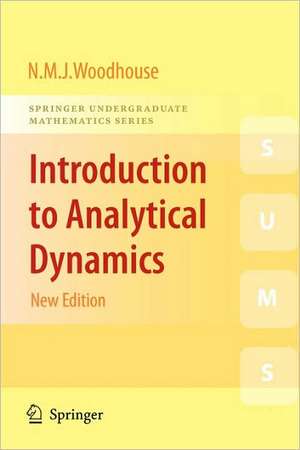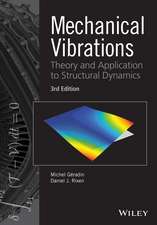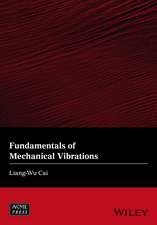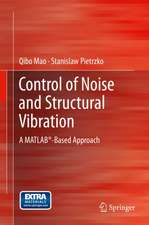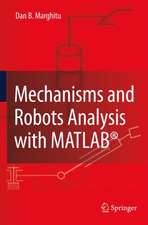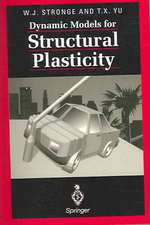Introduction to Analytical Dynamics: Springer Undergraduate Mathematics Series
Autor Nicholas Woodhouseen Limba Engleză Paperback – 4 feb 2010
This new edition has been extensively revised and updated to include:
- A chapter on symplectic geometry and the geometric interpretation of some of the coordinate calculations.
- A more systematic treatment of the conections with the phase-plane analysis of ODEs; and an improved treatment of Euler angles.
- A greater emphasis on the links to special relativity and quantum theory showing how ideas from this classical subject link into contemporary areas of mathematics and theoretical physics.
Din seria Springer Undergraduate Mathematics Series
-
 Preț: 237.29 lei
Preț: 237.29 lei -
 Preț: 358.81 lei
Preț: 358.81 lei -
 Preț: 265.90 lei
Preț: 265.90 lei -
 Preț: 318.98 lei
Preț: 318.98 lei -
 Preț: 240.63 lei
Preț: 240.63 lei -
 Preț: 237.18 lei
Preț: 237.18 lei -
 Preț: 224.54 lei
Preț: 224.54 lei -
 Preț: 237.41 lei
Preț: 237.41 lei -
 Preț: 301.10 lei
Preț: 301.10 lei -
 Preț: 236.97 lei
Preț: 236.97 lei -
 Preț: 221.92 lei
Preț: 221.92 lei -
 Preț: 325.20 lei
Preț: 325.20 lei -
 Preț: 359.09 lei
Preț: 359.09 lei -
 Preț: 268.36 lei
Preț: 268.36 lei -
 Preț: 229.86 lei
Preț: 229.86 lei -
 Preț: 236.87 lei
Preț: 236.87 lei -
 Preț: 319.90 lei
Preț: 319.90 lei -
 Preț: 359.65 lei
Preț: 359.65 lei -
 Preț: 238.28 lei
Preț: 238.28 lei -
 Preț: 283.11 lei
Preț: 283.11 lei -
 Preț: 166.75 lei
Preț: 166.75 lei -
 Preț: 266.70 lei
Preț: 266.70 lei -
 Preț: 269.99 lei
Preț: 269.99 lei - 15%
 Preț: 526.67 lei
Preț: 526.67 lei -
 Preț: 272.49 lei
Preț: 272.49 lei -
 Preț: 265.18 lei
Preț: 265.18 lei -
 Preț: 275.36 lei
Preț: 275.36 lei -
 Preț: 278.24 lei
Preț: 278.24 lei -
 Preț: 320.20 lei
Preț: 320.20 lei -
 Preț: 272.69 lei
Preț: 272.69 lei -
 Preț: 258.88 lei
Preț: 258.88 lei -
 Preț: 265.81 lei
Preț: 265.81 lei -
 Preț: 266.70 lei
Preț: 266.70 lei -
 Preț: 275.74 lei
Preț: 275.74 lei -
 Preț: 265.78 lei
Preț: 265.78 lei -
 Preț: 328.08 lei
Preț: 328.08 lei -
 Preț: 275.74 lei
Preț: 275.74 lei -
 Preț: 273.45 lei
Preț: 273.45 lei -
 Preț: 277.32 lei
Preț: 277.32 lei -
 Preț: 270.57 lei
Preț: 270.57 lei -
 Preț: 273.63 lei
Preț: 273.63 lei -
 Preț: 270.19 lei
Preț: 270.19 lei -
 Preț: 265.36 lei
Preț: 265.36 lei -
 Preț: 265.36 lei
Preț: 265.36 lei -
 Preț: 268.08 lei
Preț: 268.08 lei -
 Preț: 272.86 lei
Preț: 272.86 lei -
 Preț: 272.69 lei
Preț: 272.69 lei -
 Preț: 271.16 lei
Preț: 271.16 lei -
 Preț: 270.74 lei
Preț: 270.74 lei -
 Preț: 265.78 lei
Preț: 265.78 lei
Preț: 352.37 lei
Nou
Puncte Express: 529
Preț estimativ în valută:
67.44€ • 70.14$ • 56.43£
67.44€ • 70.14$ • 56.43£
Carte tipărită la comandă
Livrare economică 15-29 martie
Preluare comenzi: 021 569.72.76
Specificații
ISBN-13: 9781848828155
ISBN-10: 1848828152
Pagini: 256
Ilustrații: XIII, 240 p. 42 illus.
Dimensiuni: 155 x 235 x 14 mm
Greutate: 0.36 kg
Ediția:2nd ed. 2009
Editura: SPRINGER LONDON
Colecția Springer
Seria Springer Undergraduate Mathematics Series
Locul publicării:London, United Kingdom
ISBN-10: 1848828152
Pagini: 256
Ilustrații: XIII, 240 p. 42 illus.
Dimensiuni: 155 x 235 x 14 mm
Greutate: 0.36 kg
Ediția:2nd ed. 2009
Editura: SPRINGER LONDON
Colecția Springer
Seria Springer Undergraduate Mathematics Series
Locul publicării:London, United Kingdom
Public țintă
Lower undergraduateCuprins
Frames of Reference.- One Degree of Freedom.- Lagrangian Mechanics.- Noether#x2019;s Theorem.- Rigid Bodies.- Oscillations.- Hamiltonian Mechanics.- Geometry of Classical Mechanics.- Epilogue: Relativity and Quantum Theory.
Recenzii
From the reviews of the second edition:
“It is designed to teach analytical mechanics to second and third year undergraduates in the UK, and probably to third or fourth year undergraduates in the US. … This book offers a very attractive traditional introduction to the subject. … the author is well tuned to the difficulties even strong students encounter. … discusses the relevance of classical mechanics in modern physics, especially to relativity and quantum mechanics. This is a fine textbook. It would be a pleasure to teach or to learn from it.” (William J. Satzer, The Mathematical Association of America, March, 2010)
“It is designed to teach analytical mechanics to second and third year undergraduates in the UK, and probably to third or fourth year undergraduates in the US. … This book offers a very attractive traditional introduction to the subject. … the author is well tuned to the difficulties even strong students encounter. … discusses the relevance of classical mechanics in modern physics, especially to relativity and quantum mechanics. This is a fine textbook. It would be a pleasure to teach or to learn from it.” (William J. Satzer, The Mathematical Association of America, March, 2010)
Textul de pe ultima copertă
Analytical dynamics forms an important part of any undergraduate programme in applied mathematics and physics: it develops intuition about three-dimensional space and provides invaluable practice in problem solving.
First published in 1987, this text is an introduction to the core ideas. It offers concise but clear explanations and derivations to give readers a confident grasp of the chain of argument that leads from Newton’s laws through Lagrange’s equations and Hamilton’s principle, to Hamilton’s equations and canonical transformations.
This new edition has been extensively revised and updated to include:
First published in 1987, this text is an introduction to the core ideas. It offers concise but clear explanations and derivations to give readers a confident grasp of the chain of argument that leads from Newton’s laws through Lagrange’s equations and Hamilton’s principle, to Hamilton’s equations and canonical transformations.
This new edition has been extensively revised and updated to include:
- A chapter on symplectic geometry and the geometric interpretation of some of the coordinate calculations.
- A more systematic treatment of the conections with the phase-plane analysis of ODEs; and an improved treatment of Euler angles.
- A greater emphasis on the links to special relativity and quantum theory, e.g., linking Schrödinger’s equation to Hamilton-Jacobi theory, showing how ideas from this classical subject link into contemporary areas of mathematics and theoretical physics.
Caracteristici
A new edition of a classic text, extensively revised and updated in order to simplify the presentation and offer a more modern outlook, showing how ideas from classical mechanics link with contemporary research. Aims to give readers a confident grasp of the material by confronting, rather than evading, common notational and pedagogical difficulties encountered on the journey from Newton to Lagrange and Hamilton.
